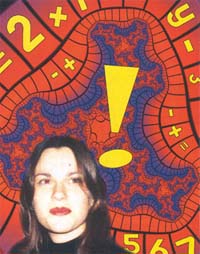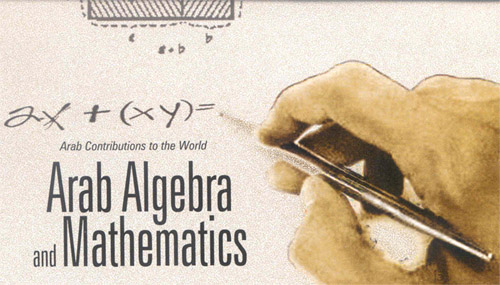|
“That fondness for science, ... that affability
and condescension which God shows to the
learned, that promptitude with which he
protects and supports them in the
elucidation of obscurities and in the
removal of difficulties, has encouraged me
to compose a short work on calculating by
al-jabr and al-muqabala, confining it to what is
easiest and most useful in arithmetic.”
Muhammad
ibn Musa al-Khwarizmi (Arab Mathematician,
780-850)
The
handmaiden of the sciences, as mathematics
is called, affects our early
school years in such a way that few of us
afterwards want to have any give and
take with the subject. Yet, ironically,
maths is all around us. One way or
another, almost every aspect of our modern
civilization is based on calculations. Be
it in architecture, astronomy, medicine,
hi-tech development and the Internet, or
mere payment in the local store, we make
use of mathematical reckoning throughout
our lives. And, are we lucky to live in
this advanced age, taking for granted all
historically accumulated knowledge in
science, much of which is based on
mathematics?
Throughout history, different centres of
civilization such as those of ancient
India, Mesopotamia, Egypt, and Greece
contributed greatly for the study of
mathematics and all its practical
functions. No less important was the role
of the Arab mathematics for the
development of the discipline, which made
popular the Arabic numeration system, the
concept of zero, geometry, and algebra.
The
Arab Contribution to Mathematics
In order to understand the history of
mathematics, it is essential to review its
development in the Muslim world in the
period from the 9th to the 15th
centuries AD.
To begin with, there was a relationship
between early Muslim mathematics and the
mathematics of Hellenistic and Sanskritic
schools, and it looks like the Arabs found
useful those earlier Greek and Hindu
pre-algebra efforts.
Learned Muslim men found interest in the
mathematical questions. As a point in
case, Thabit ibn Qurrah (836-901)
translated the works of key Greek
mathematicians for the time. As a typical
scenario, ibn Qurrah studied and improved
those Hellenistic compositions. One such
work was Nicomachus of Gerasa's
Arithmetic, which he revised and which
led him to finding the rule for amicable
numbers. These are a pair
of numbers such that each number of the
pair is the sum of the set of proper
divisors of the other number. The search
for amicable numbers since has established
a long-term fascination with them in the
Muslim centers of study. Later in history,
Kamal ad-Din al-Farisi in the 14th
century found the pair 17,926 and 18,416
as an illustration of ibn Qurrah’s rule,
and Muhammad Baqir Yazdi in the 17th
century produced the pair 9,363,584 and
9,437,056.
Al-Khwarizmi – the Great Muslim Mathematician
Among the rest of the early Arab
scientists, there is but one name that
deserves closer attention when the
influence of Muslim mathematics comes
under discussion.
It is that of the 9th century
scientist called Muhammad ibn Musa al-Khwarizmi.
Famous as the father of Algebra, he was
born about 780AD near Baghdad, and lived
until about 850AD. Al- Khwarizmi settled
in Baghdad which was under the caliphates
of al-Ma`mun and al-Mu'tasim in what is
considered to be the first Golden Age of
Muslim science He produced his most
important work in about 830, and called it
Kitab al-jabr wa’l-muqabala, or
the Book
of Restoring and Balancing.
It dealt with
"what is easiest and most
useful." From the term “al-jabr,”
translating as "restoring," in
the title, we get “algebra” which was
the way the term was translated into Latin
in the 12th century. Restoring, in this
case, referred to the method of taking a
subtracted quantity from one side and
placing it to the other side of an
equation.
Al-Khwarizmi’s book Kitab al-jabr
wa’l-muqabala proposes a set of
rules for arithmetical solutions of linear
and quadratic equations, and for
elementary geometry. It also resolves
inheritance problems regarding the
division of money according to
proportions, which was in line with the
complex requirements of Muslim religious
law. The whole work built upon an extended
tradition beginning with Babylonian
mathematics of the 2nd century BC, going
through stages of Greek, Hebrew, and Hindu
development. The book served as the prime
example for later scientists such
as the Egyptian Abu Kamil. Even
millennia later, Kitab al-jabr
wa’l-muqabala
was still used as the standard mathematics
text at universities in Europe until the
16th century.

Working as an instructor in the academic
institution known as the “House of
Wisdom,” Al-Khwarizmi explicitly
presented Indian influence in his works
and produced a book on Hindu arithmetic.
It was entitled The
Book
of
Addition and Subtraction According to the
Hindu Calculation. This volume was translated in Latin as Algoritmi
de Numero Indorum, which means “Al-Khwarizmi Concerning the Hindu Art of Reckoning.”
The “Algoritmi” in this translation of
the title made popular the term
“algorithm.” In the book, Al-Khwarizmi
tackled and found solutions for specific
algebra equations called “quadratic
equations,” which are widely used in
science today.
As a sign of service to the Muslim faith, al-Khwarizmi's
developed a method to calculate the time
of visibility of the new moon, indicating
the beginning of the Muslim month.
Another of Al-Khwarizmi’s realizations is the
arrangement of a system for quadratics. The
Latin version of Kitab
al-jabr wa’l-muqabala
sets off with the positional rule for
numbers and continues with the solutions
in six chapters of six kinds of
quadratics:
The
6 kinds of quadratics classified by al-Khwarizmi
are:
1.
Squares equal to roots (x² = square root
of 2)
2.
Squares equal to numbers (x² = 2)
3.
Roots equal to numbers (square root of x =
2)
4.
Squares and roots equal to numbers (x² +
3x = 25)
5.
Squares and numbers equal to roots (x² +
1 = 9)
6.
Roots and numbers equal to squares (3x + 4
= x²)
10th Century Arabic Mathematics
The 10th millennium saw Muslim
mathematical study concentrated in three
main sub-disciplines. These were the
ongoing progress in algebra, the
development of arithmetic algorithms,
and the increasing complexity in
geometry. In addition, the introduction
of the zero was destined to
revolutionize mathematics as it allowed
for key innovations. It was proposed by
Muhammad Bin Ahmad in 967 AD. Zero
arrived in the West much later, in 13th
century.
As a result of the work in arithmetic
development, three numeration systems
were invented. The “finger”
arithmetic used was one of them. It
relied on mental arithmetic and on the
help of the fingers to memorize results
in the course of calculation. The system
found practical application for records
of treasury administrators. The finger
system was widely used throughout the 10th
and 11th centuries, and
leading mathematicians such as Abu al-Wafa
(940-998) wrote on this system
Abu Al-Wafa
The Arab mathematician Abu Al-Wafa Al-Buzajani
translated and improved on the works of
the Greek mathematicians Euclid and
Diophantus and of forerunner Al-Khwarizmi.
Al-Wafa composed Kitab fima yahtaj
ilayh al-kuttab wa al-ummal min 'ilm al-hisab,
which translates as A Book on What is
Necessary from the Science of Arithmetic
for Scribes and Businessmen, and Kitab
fima yahtaj ilayh al-sani 'min al-a'mal
al-Handasiyha, or A Book on What is
Necessary from Geometric Construction for
the Artisan. The exceptional
achievements of Al-Wafa include the
invention of a field in geometry, which
deals with problems leading to equations
in algebra of a higher degree than the
second. His labor included work on the
polyhedral theory and
on the development of trigonometry, much
of which he put to use in astronomy. Al-Wafa’s
success in astronomy was marked by his
creation of the first wall quadrant for
studying the stars. From his observatory
in Baghdad, he used mathematics in his
lunar theory experiments, where he
employed the tangent and cotangent
trigonometric functions. In addition, Al-Wafa
formulated the secant and cosecant
functions, showed the generality of the
sine theorem for spherical triangles, and
thought of a technique of using sine
tables.
Al-Wafa’s case demonstrates the
evolvement of 10th century Islamic algebra
from Al-Khwarizmi's quadratic polynomials
to the expressions algebra understanding,
which comprised arbitrary positive or
negative integral powers of the unknown. A
movement occurred which dealt with the
similarity between the rules for operating
with powers of the unknown in algebra and
with powers of 10 in arithmetic. This
prompted an intertwined relationship
between the growth of algebra and
arithmetic from the 10th to the
12th century. Thus, by the 14th
century symbolism in algebra was widely
used in the western Muslim territories.

In the meantime, there was intense study
in other branches of algebra too. The
further improvement of earlier Hellenistic
and Sanskritic works was under way. The
basis of the ancient outcomes mixed well
with the new inventions in algebra. Muslim
mathematicians such as Abu Jafar Al-Khazan
and Abu Kamil of the 10th
century were involved in the investigation
of the equations of Diophantine. They were
also working to
prove a special case of what later became
popular as Fermat's last theorem. It
maintains that rational solution to
the equation x3 + y3
= z3 does not exist.
Apart from the progress made in the
disciplines of algebra and arithmetic, geometry
as well developed significantly. Thabit
ibn Qurrah’s grandson, Ibrahim ibn Sinan
(908-946), was involved in the study of
geometry and particularly in tangents to
circles. He also investigated the apparent
motion of the Sun and the geometry of
shadows. With his grandfather, Ibrahim
formulated a method for designing the
curves needed for sundials.
In pure mathematical terms, Ibrahim ibn
Qurrah’s most valuable labor dealt with
the quadrature of the parabola. As a
result of his efforts, he produced a
system of integration more general than
the system of Archimedes. Admitedly, it
was in fact Ibrahim’s grandfather Thabit
ibn Qurra who had begun working with
integration in a different manner than did
Archimedes. Ibrahim, however, was the one
to grasp that there were improvements on
what his grandfather had reached.
Ibrahim ibn Qurrah also deserves respect
for being the most advanced Arab
mathematician to be concerned with
mathematical philosophy. The following
passage illustrates his contemplation: “I
have found that contemporary geometers
have neglected the method of Apollonius in
analysis and synthesis, as they have in
most of the things I have brought forward,
and that they have limited themselves to
analysis alone in so restrictive a manner
that they have led people to believe that
this analysis did not correspond to the
synthesis effected.”
Arabic
Mathematics Worldwide
In the 11th century, the Arab
mathematical foundation was one of the
strongest in the world. The Muslim
mathematicians had invented geometrical
algebra and had taken it to advanced
levels, capable of solving third and
fourth degree equations. The world
witnessed a new stage in the development
of mathematical science, driven by the
numerous translated works from Arabic into
European languages.
Indubitably, Al-Khwarizmi was very
influential with his methods on arithmetic
and algebra which were translated into
much of southern Europe. Again, these
translations became popular as algorismi
– a term which is derived from the name
of Al-Khwarizmi. Not all went smoothly
nonetheless. The
Arabic numerals introduced by Al-Khwarizmi,
like much of new mathematics, were not
welcomed wholeheartedly. In fact, in 1299
there was a law in the commercial center
of Florence forbidding the use of such
numerals. Initially, only
universities dared use them, but later
they became popular with merchants, and
eventually became commonly used.
In time, Europe realized the great potential
value of the Arab mathematical
contributions and put into popular use all
that seemed practical. The sciences, with
mathematics as their essence, flourished
and developed into the disciplines we know
today. None would have been the same
though, had it not been for that book on
restoration, or had the zero not been
invented, or had the Arabic numerals not
made their way to Europe. That “fondness
of science,” which inspired an early
Arab mathematician to propose calculating
by al-jabr and al-muqabala, did much to
make the world run as we know it today.
|
